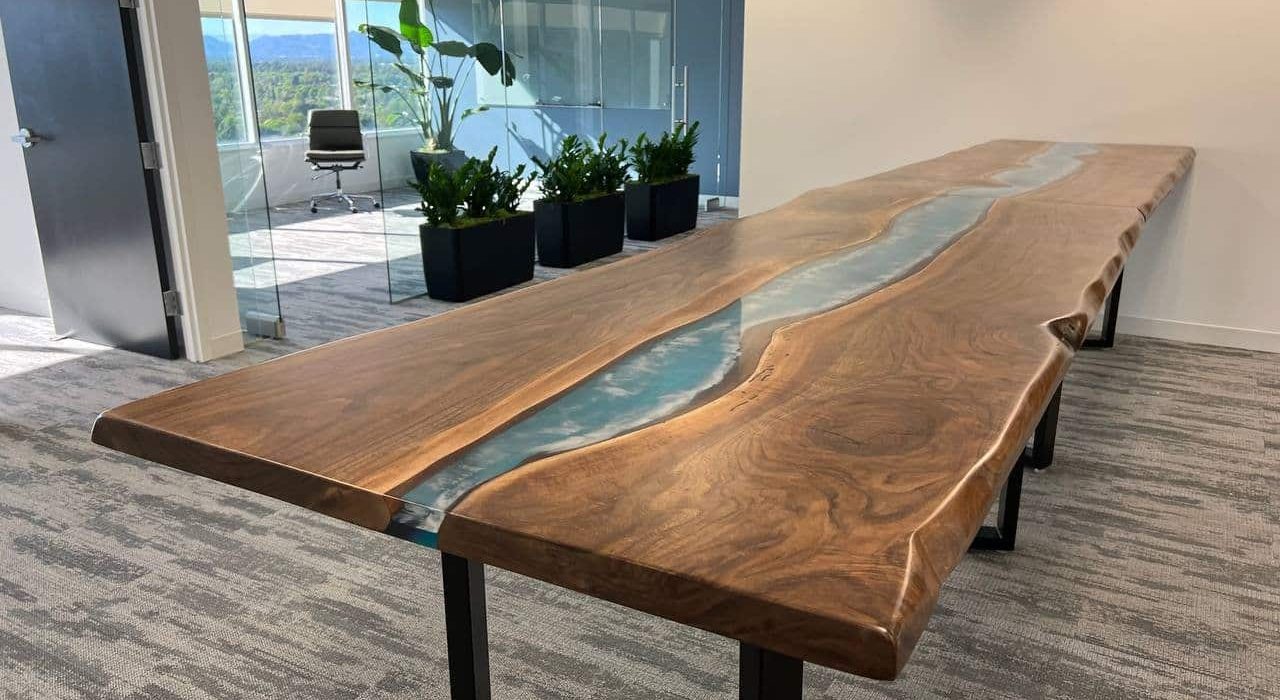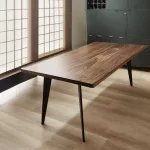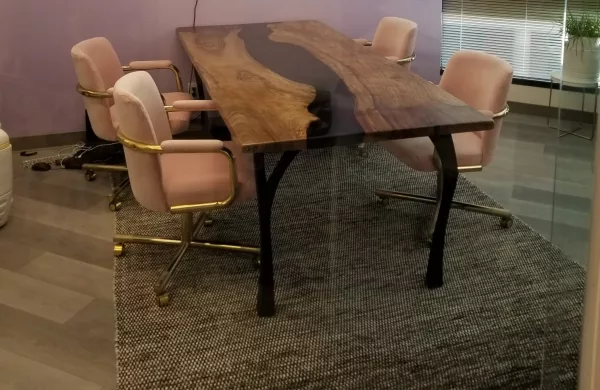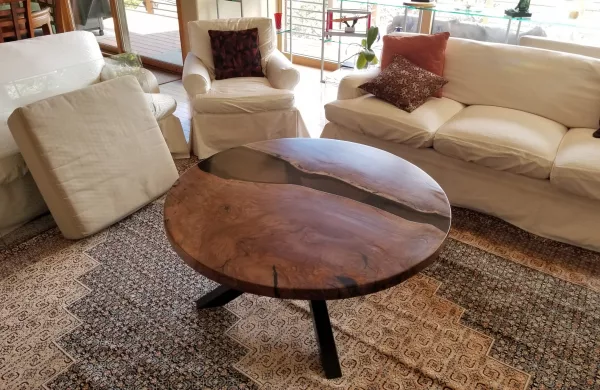
Live edge tables showcase the natural beauty of wood, including its raw edges, grain, and any imperfections, making each piece unique. The best types of wood for live edge tables are typically hardwoods due to their durability, strength, and the character they can bring to your space. Here are some popular choices:
- Walnut: Known for its rich, dark color, walnut is a premium wood for furniture making. Its durability and beautiful grain patterns make it a popular choice for live edge tables.
- Maple: With its light color and fine, smooth grain, maple is a versatile wood that fits well in both contemporary and traditional settings. It’s also very durable, making it suitable for a table that will see a lot of use.
- Cherry: Cherry wood has a warm, rich color that deepens with age. It’s moderately hard, making it durable enough for a dining table, and has a straight grain pattern that looks great when finished.
- Oak: Oak is known for its strength and durability, as well as its prominent grain pattern. It can come in white or red varieties, offering flexibility in design. Oak live edge tables are sturdy and can handle heavy use.
- Ash: Ash wood has a light color palette, with a straight grain that’s similar to oak. It’s durable and has good shock resistance, which can be beneficial for a table.
- Cedar: While softer than hardwoods, cedar is still a good choice for live edge tables, especially for those looking for a more rustic appeal. It has a distinctive smell and is naturally resistant to decay.
- Teak: Teak is highly valued for its extraordinary durability and water resistance. It’s often used for outdoor furniture but makes a beautiful indoor live edge table as well.
- Elm: Elm has a distinctive grain pattern and is known for its strength and durability. It’s less common than some other woods, making it a unique choice for a live edge table.
Pros and cons of walnut for live edge table
Walnut wood is a favored choice for live edge tables due to its striking appearance and durable nature. However, like any material, it comes with its own set of advantages and disadvantages. Here’s a closer look at the pros and cons of using walnut for a live edge table:
Pros
- Aesthetic Appeal: Walnut is renowned for its rich, deep color tones that range from light brown to dark chocolate, with purple or grey undertones. The natural grain patterns, which can include swirls and curves, add character and beauty to the furniture, making each piece unique.
- Durability: Walnut is a hardwood, which means it’s quite durable and resistant to wear. This makes it an excellent choice for a table that will be used regularly, as it can withstand the demands of daily life.
- Workability: Despite its hardness, walnut wood is relatively easy to work with in terms of cutting, shaping, and sanding. This makes it a good choice for the intricate work required to preserve and feature the live edge.
- Finishing: Walnut takes well to stains and finishes, allowing for a smooth, appealing surface that enhances its natural beauty. Its ability to take a fine polish can highlight the live edge detail even further.
- Timelessness: The elegance and rich color of walnut wood contribute to pieces that are timeless. Furniture made from walnut tends to remain in style and can become heirloom pieces passed down through generations.
Cons
- Cost: Walnut is considered a premium wood, which means it can be more expensive than other hardwoods. The cost might be a significant factor for those on a budget.
- Availability: Depending on where you are in the world, walnut can be less readily available than other woods, which can add to the cost and lead time for obtaining materials.
- Weight: Being a dense hardwood, walnut furniture can be heavy, making it potentially difficult to move or transport.
- Maintenance: While durable, walnut wood still requires maintenance to keep it looking its best. It can be prone to scratching and may fade if exposed to direct sunlight over time, requiring occasional refinishing.
- Sensitivity to Environment: Walnut wood can react to extreme changes in humidity and temperature, which might lead to warping or cracking. Properly sealing the wood and keeping it in a stable environment can mitigate these issues.
Pros and cons of maple for live edge table
Maple is another popular choice for live edge tables, appreciated for its beauty, strength, and the warmth it brings to any room. Like walnut, maple has its own set of characteristics that can make it more or less suitable depending on your project’s requirements. Here’s an overview of the pros and cons of using maple for a live edge table:
Pros
- Strength and Durability: Maple is a hardwood with a high density, making it incredibly durable and resistant to wear and tear. This makes it suitable for tables that will see frequent use.
- Aesthetic Variety: Maple wood can range in color from nearly white to a light golden or reddish brown. The wood grain is generally straight, offering a uniform appearance that can nonetheless vary significantly from piece to piece, especially when featuring the live edge.
- Workability: Despite its hardness, maple is relatively easy to work with using both hand tools and machinery, which is advantageous when crafting the natural contours of a live edge table.
- Finishing: Maple takes well to finishes, allowing for a smooth, high-quality finish that highlights the wood’s natural grain and the unique live edge. Its light color can also serve as a great base for stains if a darker color is desired.
- Availability: Maple is widely available in North America, making it a more affordable option than some exotic hardwoods. This accessibility can also lead to shorter lead times for sourcing the material.
Cons
- Prone to Fading: Maple can be sensitive to direct sunlight, leading to fading or yellowing over time. This means a live edge table made from maple may need to be strategically placed in a room to avoid prolonged sun exposure.
- Hardness Can Be a Con: While its hardness is a pro in terms of durability, it can also be a con when it comes to working the wood. Maple’s density can dull cutting tools more quickly than softer woods, requiring more frequent sharpening.
- Susceptibility to Movement: Maple can be prone to movement in response to changes in humidity, leading to potential warping or cracking. This necessitates careful acclimation of the wood to the room’s environment before the table is crafted, as well as meticulous sealing and finishing.
- Staining Can Be Uneven: Although maple takes well to finishes, achieving an even stain can sometimes be challenging due to its tight grain. This may result in blotchiness or uneven color if not properly prepared.
- Absorbs Moisture: Being a porous wood, maple can absorb moisture, which may lead to staining or warping if liquids are left on the surface for extended periods. This makes it important to clean spills promptly and may require the use of coasters or tablecloths to protect the surface.
Pros and cons of cherry for live edge table
Cherry wood is highly valued for its fine grain, smooth texture, and rich, warm colors that deepen to a reddish-brown patina over time. Its natural beauty makes it an appealing choice for live edge tables, where the unique edge of the wood is preserved to add character to the piece. Below are the pros and cons of using cherry wood for a live edge table:
Pros
- Aesthetic Appeal: Cherry’s rich color and fine grain pattern give it a visually appealing look that can enhance any room. Over time, cherry wood darkens to a deeper, more luxurious patina, which is highly sought after.
- Durability: While not as hard as some other hardwoods like maple or oak, cherry is still durable enough for everyday use. It’s a solid choice for a table that will experience regular wear and tear.
- Workability: Cherry wood is known for its ease of workability. It cuts, shapes, and sands well, which is particularly beneficial when dealing with the natural edges and unique contours of a live edge table.
- Finishing: Cherry takes finishes very well, allowing for a smooth, attractive surface that highlights the natural beauty of the wood and the distinctiveness of the live edge.
- Grain Consistency: The grain pattern in cherry wood is generally straight and uniform, which can be a desirable trait for those seeking a cleaner, more consistent look while still maintaining a natural edge.
Cons
- Cost: Cherry is considered a premium wood, and its cost can be higher than that of more common hardwoods. The price might be a consideration for those on a tight budget.
- Sensitivity to Light: Cherry wood is notably sensitive to light, and its color will darken significantly over time when exposed to sunlight. While this can be a pro for those who appreciate the deepening color, it requires consideration in placement to ensure even coloring.
- Scratches and Dents: Due to its relatively softer nature compared to other hardwoods, cherry can be more susceptible to scratches and dents. This might necessitate more careful use and maintenance, especially in high-traffic areas.
- Availability: Depending on your location, cherry wood might not be as readily available as other hardwoods, potentially affecting the project timeline or cost due to shipping.
- Finishing Sensitivity: While cherry generally finishes well, it can sometimes absorb stain unevenly, leading to blotchiness if not properly prepared. A conditioner or sealer can be necessary to achieve an even finish.
Pros and cons of oak for live edge table
Oak wood, known for its strength, durability, and distinctive grain patterns, is a popular choice for furniture, including live edge tables. Available in varieties such as white oak and red oak, it offers versatility in design and appearance. Here are the pros and cons of using oak for a live edge table:
Pros
- Durability and Strength: Oak is a hardwood that is highly durable and strong, making it ideal for tables that will be used frequently. It can withstand the rigors of daily use, making it a practical choice for a family home.
- Aesthetic Appeal: The prominent grain pattern of oak, especially visible in quartersawn pieces, adds character and beauty to furniture. The natural edges of a live edge table made from oak can highlight these unique features even more.
- Resistance to Moisture: White oak, in particular, is known for its resistance to moisture due to its tight grain. This makes it suitable for outdoor tables or for use in environments where spills are likely.
- Versatility in Finishing: Oak takes stains and finishes well, allowing for a wide range of looks. Whether you prefer a natural finish to highlight the grain or a stained appearance to match your decor, oak can accommodate both.
- Availability: Oak is widely available in many parts of the world, making it relatively affordable compared to more exotic hardwoods. This also means finding oak for your project can be easier.
Cons
- Weight: Oak is a very dense and heavy wood, which can make furniture made from it difficult to move. This could be a consideration if you plan to relocate the table frequently.
- Workability: Due to its hardness, oak can be challenging to work with. Tools must be sharp, and working the natural live edges into the desired shape may require more effort compared to softer woods.
- Tendency to Warp or Split: While oak is generally stable, it can be prone to warping or splitting if not properly dried and treated. This is particularly true for larger pieces like those used for tabletops.
- Variability in Color: The color of oak can vary significantly from piece to piece, ranging from nearly white to a deep brown. While this can add to the uniqueness of each table, it can also make it challenging to match with other oak furniture.
- Open Grain Texture: Oak’s open grain texture may require filling if a perfectly smooth surface is desired. This can add extra steps to the finishing process.
- Chemical Sensitivity: Oak can react with certain metals and chemicals, leading to staining. This means care must be taken with hardware and spills to avoid unwanted marks.
Pros and cons of teak for live edge table
Teak is a highly sought-after wood for both indoor and outdoor furniture due to its exceptional durability and natural beauty. Its use for live edge tables can add a luxurious and exotic touch to any space. Here are the pros and cons of using teak for a live edge table:
Pros
- Durability: Teak is renowned for its exceptional durability and resistance to rot, decay, and pests, such as termites. This makes it an excellent choice for a live edge table that will last for decades.
- Natural Oils: Teak wood contains natural oils that protect it from moisture, making it resistant to warping and cracking. This property also makes it ideal for use in environments with fluctuating humidity.
- Low Maintenance: Thanks to its natural oils, teak requires less maintenance compared to other woods. It can be left untreated and will naturally age to a beautiful silver-gray patina, although it can also be oiled to preserve its original color.
- Aesthetic Appeal: Teak has a beautiful golden-brown color and a straight grain pattern that can enhance the visual appeal of a live edge table. Over time, it develops a rich patina that many find appealing.
- Versatility: Suitable for both indoor and outdoor use, teak offers versatility in placement. Its natural resistance to the elements makes it one of the few woods that can be confidently used outside without concern for damage.
Cons
- Cost: Teak is one of the most expensive woods on the market, due to its superior qualities and the fact that it is primarily sourced from Southeast Asia. The high cost can make it prohibitive for some budgets.
- Availability: Restrictions on the harvesting of teak trees to prevent deforestation mean that teak is not as readily available as other types of wood. This can make sourcing large pieces for a live edge table more challenging.
- Weight: Teak is a dense and heavy wood, making furniture made from it quite heavy. This can make transportation and placement of a teak live edge table more difficult.
- Over-Oiling: While teak’s natural oils are a benefit, there is a tendency to over-oil teak furniture. This can lead to a build-up that attracts dust and dirt, requiring more frequent cleaning.
- Color Uniformity: If maintaining the original golden-brown color is desired, regular maintenance and oiling are necessary. Otherwise, the wood will naturally age to a grayish tone, which may not be to everyone’s liking.
- Hardness: While teak is durable, it is not as hard as some other types of wood like oak or maple. This means it might be more susceptible to scratches and dents, especially in a high-use item like a table.
When choosing the wood for your live edge table, consider the overall aesthetic you’re aiming for, as well as the table’s intended use. Durability, grain pattern, and color are all important factors, but so is the wood’s origin and sustainability. Many people prefer to use locally sourced wood or reclaimed wood for their live edge tables to add an extra layer of character and story to their piece.








